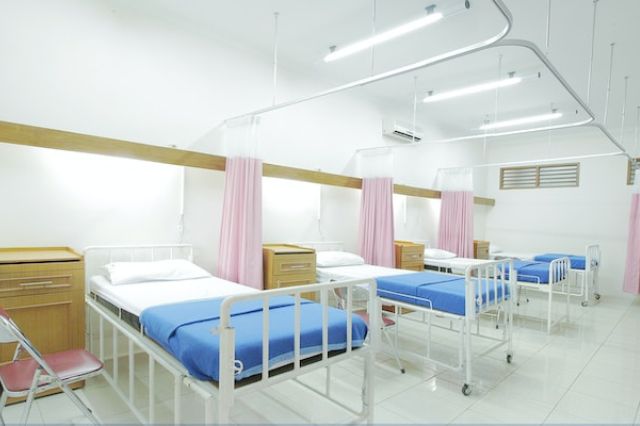Wellbeing
The Incredible Physical and Mental Health Benefits of Yoga

Yoga is also a practice that has been around for centuries and is designed to build both physical and mental strength. It can be used to increase flexibility and strength, improve breathing, reduce stress, and improve overall well-being. In this article, we will explore how yoga can benefit both mental and physical health.
Physical Benefits of Yoga
1. Increased Flexibility and Range of Motion: Yoga is a great way to stretch and loosen up your muscles. With regular yoga practice, you will be able to increase the range of motion in your joints and improve your flexibility.
2. Improved Muscle Strength: The poses in yoga require you to use your muscles to support your body. This will help to increase strength in your muscles and help your body become stronger.
3. Improved Posture: Yoga will help you to build a stronger core, which in turn will help improve your posture. Good posture requires a lot of core strength and yoga is a great way to achieve this.
4. Improved Cardiovascular Health: Yoga can help to strengthen your heart and lungs. This will not only keep you fit and healthy, but it can also reduce your risk of developing certain cardiovascular diseases.
5. Improved Balance and Coordination: Yoga helps to improve your balance and coordination, which are important skills to have. Improving these skills can help to reduce the risk of falls and other injuries.
6. Reduced Pain: This is especially beneficial for those who suffer from chronic pain. Performing certain poses while focusing on breathing can help to reduce pain and discomfort in the body.
7. Improved Digestion: Yoga poses and breathing techniques can help to reduce stress and improve the digestive system. This can help to improve your overall digestive health.
8. Improved Sleep Quality: Yoga can relax the mind and body, which can help to improve the quality of your sleep. Getting enough quality sleep can help to improve your energy levels and overall health.
9. Weight Loss: Regularly practicing yoga can help to burn calories, improve muscle strength, and reduce stress. All of these benefits can contribute to weight loss and a healthier body.
10. Stress Release: Stress can have an effect on both mental and physical health. Regularly performing yoga can help to reduce stress and provide an outlet for emotional release.
Mental Benefits of Yoga
1. Improved Concentration and Focus: Yoga can help to relax the mind and improve concentration. This can help to focus better, both in practice and in everyday life.
2. Increased Self-Awareness: Yoga encourages self-reflection, which can help to build a better understanding of yourself. Knowing yourself better can help to improve emotional regulation and decision-making abilities.
3. Reduced Anxiety and Depression: Regularly doing yoga can help to reduce symptoms of anxiety and depression. This is due to the endorphins released during yoga practice and the relaxation effects it has on the mind and body.
4. Improved Memory: Practicing yoga can help to improve your memory. This is due to the increased concentration and focus you will develop as part of your practice.
5. Greater Self-Confidence: With regular yoga practice, you will be able to improve your strength and flexibility. These results can help to boost your self-confidence and overall sense of well-being.
6. Improved Mood: Practicing yoga can help to reduce stress, release endorphins, and improve your mental state. All of this can help to improve your mood and overall emotional health.
7. Improved Creativity: With improved self-awareness, concentration, and focus, yoga can help to improve creativity and problem-solving. These skills can be beneficial in many aspects of life.
8. Improved Coping Skills: The practice of yoga can help to build mental resilience and improve the ability to cope with various situations. This can help to make stress easier to manage and reduce risk of depression.
9. Psychological Detox: Often, yoga can help to bring clarity and insight into your mental and emotional states. This can help to detoxify your emotions and make it easier to address psychological problems.
10. Improved Life Satisfaction: Yoga can help to improve your overall physical and mental health. This can lead to improved satisfaction with life, social life, and self-satisfaction.
How to include yoga daily into the life of a working individual
1. Set a routine: Establishing a set time to meditate and practice yoga can help to make it a regular part of your day. Consider fitting in a quick 10 to 15 minute yoga session when you wake up, or get a few minutes of practice in during your lunch break.
2. Get creative: With so many yoga poses and styles, you don’t need to go to a class to get in a daily yoga practice. Try using internet tutorials or watching YouTube videos of easy, quick routines, or look for inventive uses of furniture or tap into chair yoga poses to get creative with your practice.
3. Find ways to stay connected: Online classes, apps, and streaming services offer a variety of options to fit different needs and time availability. Consider trying out several streaming services to find the one that works best for you.
4. Prioritize rest time: Schedule times to rest and relax each day, in addition to dedicated yoga time. Taking breaks throughout the day, or at least once or twice before you go to bed, can help you feel more relaxed and can support better sleep.
5. Make note of your progress: Keeping track of what poses you’ve done and the progress you’ve made can be a great way to stay motivated. Having something to look back on and be proud of can give you the impetus to keep going.
Other alternatives to Yoga
• Tai Chi: This ancient Chinese martial art combines slow and smooth body movements with meditation, breathing exercises, and focus on the present moment.
• Pilates: Pilates is a form of exercise that emphasizes strengthening the core muscles, helping the body maintain good posture, strength, flexibility, and balance.
• Barre: Barre classes focus on isometric strength training combines principles of Pilates, yoga, and ballet.
• Strength Training: Strength training uses resistance, like weights, bands, or your own body weight, to increase muscle strength, improve bone density, and boost your metabolism.
• Dance: Social dances and structured ballroom classes can be great cardio, endurance-building exercises that offer many of the same benefits of yoga, such as relieving stress and increasing relaxation.
Yoga is a practice that can be used to improve both physical and mental health. It can help to increase flexibility and strength, improve breathing, reduce stress, and improve overall well-being. With so many benefits, it is clear that regular yoga practice can significantly improve both physical and mental health.
Wellbeing
Exploring the Entourage Effect with CBD


In recent years, CBD (cannabidiol) has taken the wellness world by storm, touted for its potential therapeutic benefits and minimal side effects.
As the popularity of CBD products soars, researchers and enthusiasts alike are uncovering the significance of an intriguing phenomenon known as the “Entourage Effect.” Whether you’re implementing CBD into your day with the help of CBD tea bags or CBD oil, this captivating interaction between cannabinoids has the potential to revolutionize how we view and use CBD as a therapeutic remedy.
Let’s delve into the world of CBD and explore the entourage effect.
Understanding the Basics: What is CBD?
Before we dive into the entourage effect, let’s briefly recap what CBD is. CBD is a naturally occurring compound found in the Cannabis sativa plant. Unlike its counterpart THC (tetrahydrocannabinol), CBD does not produce psychoactive effects, making it an attractive option for those seeking relief without the intoxicating high.
The Entourage Effect: A Synergistic Symphony
The entourage effect is a concept that suggests the combination of multiple cannabinoids, terpenes, and other plant compounds found in cannabis enhances the therapeutic potential of CBD. In other words, these compounds work together in harmony, producing a more profound and comprehensive effect than CBD alone.
Cannabinoids at Play: A Symphony of Healing
CBD and THC: Yin and Yang
The most well-known duo of cannabinoids is CBD and THC. While CBD offers a non-intoxicating and calming influence, THC provides a euphoric experience. When combined in the right ratio, as seen in some full-spectrum CBD products, they complement each other, potentially optimizing therapeutic outcomes.
The Lesser-Known Cannabinoids
CBD is just one of over a hundred cannabinoids present in the cannabis plant. Cannabinoids like CBG (cannabigerol), CBC (cannabichromene), and CBN (cannabinol) add their unique attributes to the entourage effect. CBG has shown promise in supporting brain health, CBC exhibits anti-inflammatory properties, and CBN may aid in sleep regulation.
Unravelling the Role of Terpenes
Terpenes are aromatic compounds found in cannabis that contribute to its distinctive smell and taste. Beyond aesthetics, terpenes play a crucial role in the entourage effect. They have their own therapeutic properties and can influence the way cannabinoids interact with our bodies. For instance, terpene myrcene is known for its potential sedative effect, while limonene may have uplifting and mood-enhancing qualities.
The Science Behind the Synergy
Enhanced Bioavailability
One way the entourage effect manifests is through increased bioavailability. When cannabinoids and terpenes work together, they may improve the absorption of CBD in the body, allowing for more efficient utilization of its therapeutic properties.
Targeting the Endocannabinoid System (ECS)
The endocannabinoid system, a complex network of receptors throughout the body, plays a vital role in regulating various physiological processes. The entourage effect may optimize the interaction between cannabinoids and the ECS, potentially leading to a more balanced and robust therapeutic response.
Making the Most of the Entourage Effect: Choosing the Right Products
To experience the full potential of the entourage effect, selecting the right CBD products is crucial. Full-spectrum CBD products contain a diverse range of cannabinoids and terpenes, offering a more comprehensive entourage effect. Broad-spectrum CBD products, on the other hand, contain multiple cannabinoids and terpenes but are THC-free, making them suitable for those who want to avoid even trace amounts of THC.
The Future of CBD and the Entourage Effect
As the world of CBD research continues to expand, we can expect to gain deeper insights into the entourage effect and how different combinations of cannabinoids and terpenes influence its outcomes. The entourage effect has the potential to reshape the CBD industry and redefine how we approach natural remedies and wellness.
The entourage effect presents an exciting avenue for CBD enthusiasts and researchers alike. As we uncover more about the synergistic interactions between cannabinoids and terpenes, we may unlock the true therapeutic potential of CBD and cannabis as a whole. Embracing the entourage effect could be a game-changer, providing us with a holistic approach to wellness and redefining our relationship with these remarkable plant compounds.
Wellbeing
Follow This Comprehensive Guide and Furnish Your Private Practice


Setting up a private practice is an exciting endeavor for healthcare professionals. It provides an opportunity to create a comfortable and welcoming space where patients can receive personalized care. However, furnishing a private practice requires careful planning and attention to detail. In this comprehensive guide, we will explore the essential steps to furnish your private practice and create an environment that promotes healing and well-being.
Planning and Designing Your Private Practice
Before embarking on furnishing your private practice, it is crucial to plan and design the space effectively. Start by identifying your target clientele and understanding their needs. This knowledge will help you make informed decisions about the layout, color schemes, and overall ambiance of your practice. Additionally, set clear goals and objectives for your practice and establish a realistic budget to guide your decision-making process.
Choosing the right location for your practice is also a critical factor. Consider factors such as accessibility, proximity to public transportation, and the local demographic. Furthermore, familiarize yourself with zoning regulations and permits to ensure compliance with legal requirements.
Creating an Inviting Reception Area
The reception area is your patients’ first point of contact, making it a crucial area to focus on when furnishing your private practice. Design the reception area to be welcoming and comfortable. Choose furniture that provides adequate seating and consider ergonomic options to ensure patient comfort. Incorporate soothing colors and lighting to create a calming atmosphere. Display informative materials such as brochures or magazines that educate and engage patients while they wait. Add personal touches and decor elements to reflect your practice’s unique identity and create a warm environment.
Establishing Functional Examination and Treatment Rooms
The examination and treatment rooms are where the actual medical procedures take place. Design these spaces with functionality and efficiency in mind. Ensure that the patient examination rooms are well-organized, allowing easy access to equipment and supplies. Acquire specialized medical equipment and instruments needed for your specific practice area.
Create a treatment area that is comfortable and functional for both patients and healthcare providers. Consider lighting, adjustable treatment tables, and privacy curtains to enhance the patient experience. Regarding privacy curtains, one essential element to consider is the installation of hospital curtain tracks when outfitting your practice. Hospital curtain tracks are vital in maintaining privacy and creating separate spaces within your practice. These tracks allow you to install curtains that can be drawn to create private areas for patient consultations, examinations, or treatments. They provide a flexible solution for maintaining confidentiality while optimizing available space. Furthermore, prioritize cleanliness and organization to maintain a sterile environment that meets the highest hygiene standards.
Equipping Your Practice with Essential Tools and Equipment
Equipping your private practice with the right tools and equipment is vital for delivering quality care. Start by identifying the necessary equipment specific to your field of practice, such as examination tables, medical devices, and diagnostic tools. Research suppliers and invest in high-quality medical supplies to ensure the safety and well-being of your patients.
In addition to medical equipment, it is essential to install reliable technology and communication systems. These include computers, software for electronic medical records, appointment scheduling systems, and secure internet connectivity. Furthermore, consider ergonomic furniture and fixtures for both patients and staff to promote comfort and reduce strain during consultations and treatments.
Implementing Effective Storage and Organization Solutions
An organized and well-managed practice is essential for smooth operations. Assess your storage needs and invest in smart storage solutions for medical supplies, equipment, and administrative materials. Optimize space utilization by using cabinets, shelves, and bins to keep everything organized and easily accessible.
Develop efficient systems for patient records and administrative paperwork, such as labeling and categorizing documents. Streamline inventory management processes by implementing digital systems that allow for easy tracking and reordering of supplies. Additionally, consider utilizing digital storage and backup systems to protect patient data and ensure its accessibility.
Enhancing the Ambience with Décor and Aesthetics
The aesthetic appeal of your private practice plays a crucial role in creating a calming and welcoming environment. Choose a cohesive and professional color scheme that aligns with your practice’s brand identity. Incorporate artwork and decorative elements that promote relaxation and inspire positivity. Natural elements such as plants and natural light can contribute to a serene atmosphere.
Maintaining cleanliness and hygiene is vital for patient confidence and comfort. Regularly clean and sanitize all areas, ensuring a fresh and inviting space for patients. Additionally, establish maintenance routines to address any issues promptly and keep the practice in optimal condition.
Ensuring Privacy and Security Measures
Patient privacy and data security are paramount in a private practice. Implement privacy policies and procedures to safeguard patient information. Utilize secure patient data management systems and ensure that staff members are trained on confidentiality and privacy protocols. Install physical security measures such as surveillance cameras and access control systems to protect both patient information and physical assets.
Hiring and Training Support Staff
Hiring and training support staff is a vital component of establishing a successful private practice. Your support staff plays a crucial role in providing efficient and effective patient care, managing administrative tasks, and creating a positive experience for your patients. When it comes to staffing your practice, it’s important to consider several factors to ensure you have a capable and well-rounded team.
First and foremost, clearly identify the necessary roles and responsibilities within your practice. This includes positions such as receptionists, medical assistants, nurses, billing specialists, and any other personnel required for the smooth operation of your practice. Determine the specific skills and qualifications needed for each role to attract candidates who align with your practice’s requirements.
Developing a comprehensive hiring and recruitment process is crucial to finding the right individuals for your practice. This process may include advertising job openings, reviewing resumes and applications, conducting interviews, and checking references. It’s important to assess candidates not only for their skills and qualifications but also for their fit with your practice’s culture and values.
Once you have selected the right individuals, providing comprehensive training is essential to ensure they are well-prepared for their roles. Create a structured training program that covers all aspects of your practice, including protocols, procedures, and software systems they will be using. This training should also emphasize the importance of patient care, confidentiality, and professionalism.
In addition to initial training, ongoing professional development and education are crucial to keep your support staff up-to-date with industry standards and advancements. Encourage your staff to participate in relevant workshops, seminars, and continuing education programs. This investment in their professional growth not only benefits your practice but also enhances their skills and job satisfaction.
Nurturing a positive and supportive work environment is equally important. Foster open communication and collaboration among your staff members, creating a culture of teamwork and mutual respect. Encourage regular feedback from your staff and provide opportunities for them to voice their concerns or suggestions for improvement. Recognize and reward their hard work, which can contribute to high morale and staff retention.
Maintaining and Updating Your Private Practice
Once your private practice is up and running, it is essential to maintain and update it regularly. Implement regular maintenance and cleaning routines to keep the space in optimal condition. Service and calibrate equipment periodically to ensure accuracy and functionality.
Stay up-to-date with industry trends and advancements to offer the best possible care to your patients. Seek feedback from patients and staff to identify areas for improvement and implement necessary changes. Adapt and evolve your practice as it grows to accommodate changing needs and demands.


Furnishing your private practice is an important step in creating a comfortable and inviting environment for your patients. By following this comprehensive guide, you can plan, design, and equip your practice effectively. Paying attention to details such as the reception area, examination rooms, storage solutions, ambience, privacy measures, staff hiring and training, and regular maintenance will contribute to a successful and thriving practice. Take action today and create a private practice that provides the highest quality care and promotes the well-being of your patients.
Wellbeing
The Science Behind CBD Flower: How Cannabinoids Interact with the Body


CBD has gained significant popularity in recent years for its potential therapeutic benefits. Derived from the hemp plant, CBD is available in various forms, including oils, capsules, and edibles.
However, one form that has gained traction among users is CBD flowers. CBD flowers refer to the dried and cured buds of the hemp plant, which can be smoked or vaporised. In this article, we will explore the science behind CBD flowers and how cannabinoids interact with the body.
Understanding Cannabinoids
Cannabinoids are a group of chemical compounds found in the cannabis plant, including CBD and THC (tetrahydrocannabinol). CBD is non-intoxicating, meaning it does not produce the “high” associated with THC. When consumed, cannabinoids interact with the body’s endocannabinoid system (ECS), a complex cell-signalling system involved in regulating various physiological processes.
The Endocannabinoid System (ECS)
The ECS comprises three main components: endocannabinoids, receptors, and enzymes. Endocannabinoids are naturally occurring cannabinoids produced by the body. Receptors, known as CB1 and CB2 receptors, are found throughout the body and are responsible for receiving and transmitting signals. Enzymes are responsible for breaking down endocannabinoids once their function is complete.
Cannabinoids and the ECS
When CBD is consumed in the form of CBD flower, it interacts with the ECS by influencing the activity of endocannabinoids and their receptors. CBD does not directly bind to CB1 or CB2 receptors but instead modulates their activity. This modulation can result in various effects, such as reducing inflammation, alleviating pain, and promoting relaxation.
Potential Therapeutic Effects
CBD flower has been studied for its potential therapeutic effects, and research suggests it may have several benefits. Here are some of the key areas where CBD flower shows promise:
- Pain Management: CBD has shown potential as an analgesic, or pain-relieving agent. It may help reduce chronic pain by interacting with receptors involved in pain perception.
- Anxiety and Stress Reduction: CBD has been reported to have anxiolytic (anti-anxiety) properties, with some studies indicating its potential in reducing anxiety disorders and stress.
- Anti-Inflammatory Properties: CBD exhibits anti-inflammatory effects by interacting with receptors involved in the immune system’s response. This could be beneficial for conditions such as arthritis and inflammatory bowel diseases.
- Sleep Improvement: CBD may promote better sleep by reducing anxiety and improving sleep quality. It could potentially benefit individuals with insomnia or other sleep disorders.
- Neuroprotective Effects: CBD has shown promise in studies related to neurodegenerative diseases, such as Alzheimer’s and Parkinson’s. It may help protect brain cells from damage and reduce inflammation in the nervous system.
Safety Considerations
While CBD flower is generally considered safe, it’s important to be aware of a few factors. Firstly, CBD can interact with certain medications, so it’s crucial to consult a healthcare professional before using CBD if you are taking any prescription medications. Additionally, CBD flowers may contain trace amounts of THC, which could lead to a positive drug test result. The quality and sourcing of CBD flowers are crucial. Look for products that undergo third-party lab testing to ensure they are free from contaminants and contain the advertised amounts of CBD.
CBD flower offers a natural and convenient way to consume CBD and experience its potential therapeutic effects. Through its interaction with the body’s endocannabinoid system, CBD can modulate various physiological processes and provide relief for conditions such as pain, anxiety, inflammation, and sleep disorders.
-



 Captions3 years ago
Captions3 years ago341 Sexy Captions to Fire Up Your Instagram Pictures
-



 Captions3 years ago
Captions3 years ago311 Night Out Captions for Instagram and Your Crazy Night
-



 Captions3 years ago
Captions3 years ago245 Saree Captions for Instagram to Boost Your Selfies in Saree
-



 Captions3 years ago
Captions3 years ago256 Best Ethnic Wear Captions for Instagram on Traditional Dress
-



 Captions3 years ago
Captions3 years ago230 Blurred Picture Captions for Instagram
-



 Captions3 years ago
Captions3 years ago275 Deep Captions for Instagram to Express Your Thoughts
-



 Quotes3 years ago
Quotes3 years ago222 Nail Captions for Instagram to Showcase Your Fresh Manicure
-



 Captions3 years ago
Captions3 years ago211 Laughing Captions for Instagram | Laughter Is the Best Medicine







